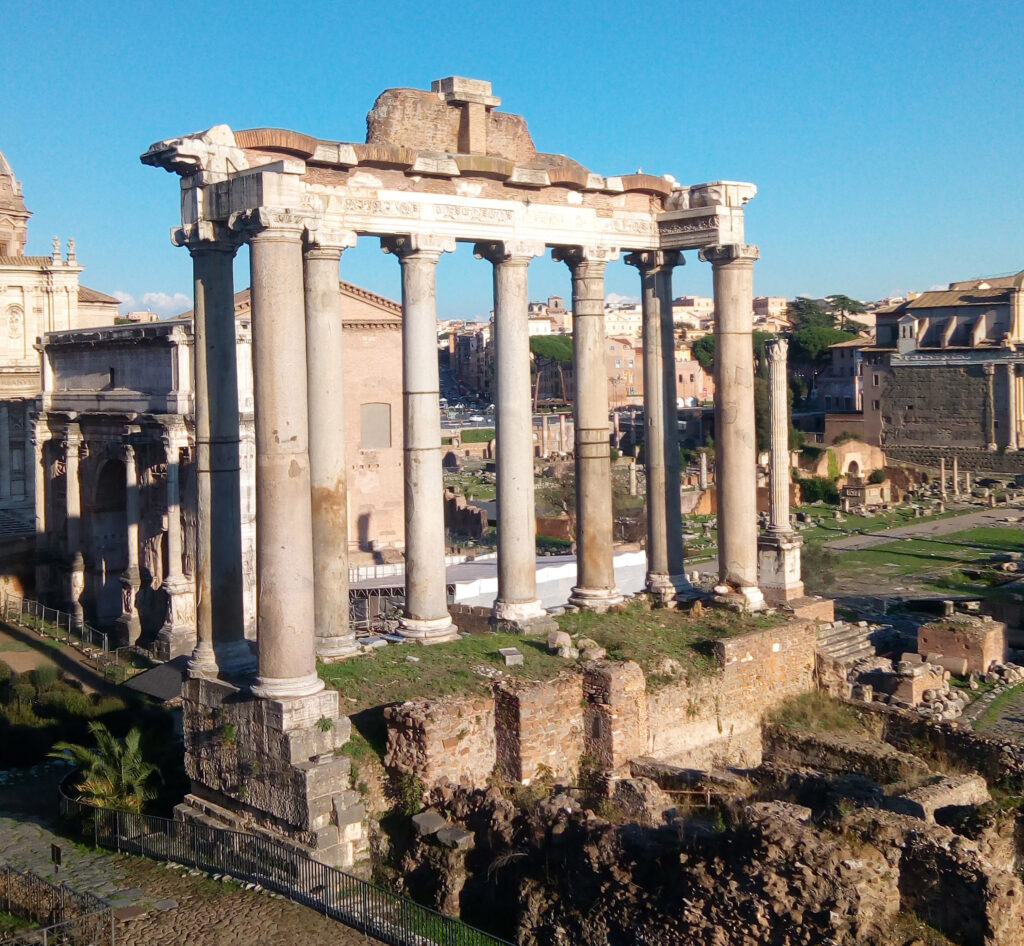the Saturnalia festival: the Roman Christmas
The temple of Saturn is one of the most impressive and photographated ruins of the Forum in Rome. But what do you know about his master, the god Saturn?
Yes, he is the Roman version of Kronos, the father of Zeus, but there is more.
Let’s discover his myth and the famous ancient roman festival Saturnalia, celebrated in December as our Christmas.
According to an old Roman myth, the god Saturn, exiled by his son Jupiter, arrived in Rome centuries before its foundation.
He was an old man, dressed in a purple cloak and holding a scythe.
His name Saturn was connected to the word SATUS (sowin), for his being who introduced farming in the area, and his wife was the goddess of prosperity Ops, the mother of every living being.
he was welcomed by the local god Gianus, the two faces god of beginnings, who donated him the Capitoline Hill (named after him “Mons Saturnius”).
His arrival started the “time of Saturn”, the golden age, a season of peace and happiness, when man were living together without greed and violence, and the ground was providing food without any hard work.
When Saturn suddenly”disappeared”, the age of Jupiter begun: the age of men, with labour, violence and social divisions.
The Romans of the republican age knows very little about the original character of the God, due to the massive hellenization of the local myths, ended in the fusion with the Greek titan Kronos.
Despite that, the god Saturn has always been central in the Roman literature and popular devotion, especially as the bearer of the golden age, a mythical lost moment of happiness. No wonder that his festivity was one of the most important in Rome: Saturnalia, every year from December the 17th to 23rd.
The official day of celebration was the 17th of December, a public cerimony was celebrated on the altar of Saturn at the slope of the Capitoline Hill, where even today stand the Temple of Saturn: maybe for its connection of a mytical age of prosperity, Saturn was also the keeper of the state treasury.
The sacrifice was followed by a rich banquet, ending with the guests screaming loud the salute: “Io, Saturnalia!” (I, Saturnalia).
The celebration was followed by 7 days of holidays.
During this festivity the rules of the Roman society were turned upside down, trying maybe to to replicate the golden age of Saturn: no transactions, no lawsuits (tribunals were closed) no farming, no separation of social classes. According to Seneca “All Rome seems to go mad during Saturnalia“
Slaves were served by their masters, the patricians were dressed like liberti (freedmen).
All men were equal, and slaves were onorated like maybe in original version of the festivity the farmers: it’s the end of the harvest season, after the seeding, we all rest, waiting for Spring, while the God Saturn is protecting the seed.
The most popular part of the celebration was the exchange of small gifts as sigillaria (terracotta dolls) or caeri (wax candles).
During this short festival, illegal and socially condemned activities like gambling were allowed and tolerated: only during Saturnalia was OK to earn money without any labour, like happened during the Saturn reign.

It’s a week of chaotic freedom, the passage to the new year before the arrival of Janus, the celebration of the end of the the season, connected to the winter solstice date. This date (December the 21st or 22nd of December) has been a significant date in many religions and cultures and represents the death and rebirth of the Sun.
Another pagan festivity happening in the same week precisely on December the 25th, was the Natalis Invicti, the day of Mithra Sol Invictus (but this god become popular only starting from the III AD).
Of course you can see similarites bewteen Saturnalia and our Holiday season, with Christmas and the celebration of the New Year.
It’s not a coincidence of course: with the conversion of the Romans to Christianity and the ban of paganism (380 AD), many pagan traditions were absorbed by the newborn Christian community.
Years later, the date of the winter solstice was chosen as a supposed birthdate for Jesus to erase the memories of the famous Saturnalia and the Mithra festivity. In fact in the narration of the birth of Jesus in the Gospels of Luke and Matthew there is no mention of a precise date or event useful to place the birth of Jesus in December. The choice of the 25th of December was based on calculations made by scholars of the VI century.
So again, there is a connection between a popular and ancient festivity and a tradition that we are still celebrating today.